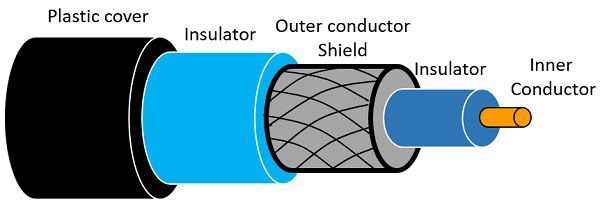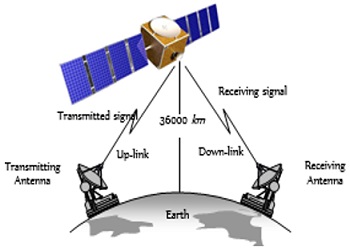Transmission mode
Transmission refers to the process of the data travelling
process from one point to another.
There are three modes of data transmission correspond to the three types of circuits available. These are:
1. Simplex 2. Half-duplex 3. Full duplex
Simplex:-
Simplex communicates imply a simple method of communication. In this communication there is one way communication. Television is a very good example of this communication. The main transmitter sends out a signal but is doesn’t expect a reply as the receiving unit can’t issue a reply back to transmitter.Half duplex :-
In half duplex, both units Communicates over
the same medium, but only one unit can send at a time. While one unit is in
send mode the other unit is in receiving mode. Walkie-talkie is a good example of
half duplex.
Full duplex:-
Full duplex communication
allows information to flow simultaneously in both the directions on
transmission path. Use of full duplex improve the efficiency line of the
communication. Internet uses full duplex communication.
Transmission media
Transmission media reference to the actual
physical channel of the transmission. There are several physical channel
through which data can be send Or receive from one point to another in a local
area network. Media is divided into two categories.
Guided media
Guided media reference to the method of
sending a data over which signal can travel in a network. Guided media is
bounded to their region.
Twisted pair
A twisted pair cable consist of two
insulted copper wire typically 1mm thickness. The wires are twisting together.
The purpose of twisting a wire is to reduce electrical interference from similar pairs of the wire.
(II) It is the least expensive media of transmission.
Advantage of Twisted pair cable.
(I) Being the older method repairment and service surface of the cables are easily available.(II) It is the least expensive media of transmission.
(III) It can be used for both analog and digital communication.
(II)It is lightly to break easily.
 Coaxial cable consists of a stiff(teak)copper wire as the cable wire as the code, surrounded by insulator material the insulator is encased by a cylindrical conductor offen as a closely wired braided mesh. The outer conductor is protected by plastic jacket. The signal is transmitted by a inner copper wire and it is electrically protected by the other metal mash. Twisted pair cables available in two kinds.
Coaxial cable consists of a stiff(teak)copper wire as the cable wire as the code, surrounded by insulator material the insulator is encased by a cylindrical conductor offen as a closely wired braided mesh. The outer conductor is protected by plastic jacket. The signal is transmitted by a inner copper wire and it is electrically protected by the other metal mash. Twisted pair cables available in two kinds.
One kind 50 OHM, widely used in digital transmission. The other kind 750 OHM, commonly used for cable TV transmission. Coaxial cable has a band wide in the range of 300 to 400 MHz
(I) light emitting diode(LED)
(II) Light Amplification by Stimulated Emission of Radiation LASER)
(I) Higher bandwidth- it can support higher bandwidth and hence can transfer data at a higher rate.
(II) These cables are much lighter than the copper cables.
(III) These cables are more immune to immune to tapping than the copper cables.
(IV) Immunity to electromagnetic interface.
(V) less signal attenuation - its transmission distance is greater than the twisted pair and it can run for 50 kilometre without regeneration.Disadvantage of Twisted Pair
(I) Easily pickup noise signal which results into higher rate of error.(II)It is lightly to break easily.
Coaxial cable

One kind 50 OHM, widely used in digital transmission. The other kind 750 OHM, commonly used for cable TV transmission. Coaxial cable has a band wide in the range of 300 to 400 MHz
Fiber optic cable
Fiber optic uses reflection to guide light through a channel. The fiber optic cable is the newest form of guided media. This media is superior in data handling and security characteristic. The fiber optic cable transmit light signals rather than electromagnetic signals. There are two sources available for fiber optic cable for data transmission these are(I) light emitting diode(LED)
(II) Light Amplification by Stimulated Emission of Radiation LASER)
Advantages of Fiber optic cable
(I) Higher bandwidth- it can support higher bandwidth and hence can transfer data at a higher rate.
(II) These cables are much lighter than the copper cables.
(III) These cables are more immune to immune to tapping than the copper cables.
(IV) Immunity to electromagnetic interface.
Disadvantages
(I) Installation or maintenance- it needs is expertise which is not available everywhere.(II) Undirectional- propagation of light is a direction undirectional and we need two fibres for bidirectional communication.
(III) Costly- the cables and interfaces used are relatively expensive.
Unguided Media
Unguided media is used for transmitting the signal without any physical media. It transports electromagnetic waves and is often called wireless communication. Signals are broadcast through air and received by all who have device to receive them. Media in which the signals are not guided through a solid medium or signals are unbounded are known as unguided media there are several methods which are in used to transmit electromagnetic energy are as follow:(I) Radio wave(II) Micro wave(III) Infrared
1. Radio wave
Radio signals have been used for a long time to transmit analogue information.
Electromagnetic waves ranging in frequencies between 3 kilo-Hertz and 1 Giga-Hertz are normally called radio waves. Radio waves are easy to generate and can travel long distances and can penetrate buildings easily, therefore widely used for communication. These are omni-directional which implies that these travel in all directions from the source, so the transmitter and receiver do not have to be carefully aligned physically.Characteristics of radio waves
1. Radio waves are easily to generate2. They can travel long distance
3. they are used in both indoor and outdoor communication because they can penetrated (pass through) any solid object.
4. They are omni-directional means they can travel in all the directions from the source so that the transmitter and receiver don't have to be carefully physical aligned.
Microwave transmission
Microwave can transmit signals between hundred megahertz to 10 gigahertz they are directionally the Waves travel in short line can therefore normally for casted the signal are transmit and receiving can be done using parabolic directional antennas unlike radio waves microwaves don't pass through building microwaves transmission depends upon weather and frequency. Microwaves is by far the most widely used form , form of radio transmission it operates in the gigahertz range with data rate in order to hundreds of Mbps per channel telecommunication carries and TV stations are the primary users of microwave transmission.
Unidirectional property of microwave helps in avoiding interference by a pair of aligned Antennas to another.High frequency microwaves cannot be receive inside the building.
Types of microwave communication system
There are two types of microwave communication system:-
(I) Terrestrial
(II) Satellite
(I)Terrestrial
(II) Satellite

3. Infrared
Infrared signals range between 300 gigahertz to 400 Tera-Hertz. These can be used for short range communication. High range infrared rays cannot be used for long range communication at is cannot be penetrate walls. This also helps in avoiding interface.
Infrared signals are generated and received using optical transceivers. Infrared systems represent a cheap alternative to most other methods, because there is no cabling involved and necessary equipment its relatively cheap. Data rate similar to those of twisted pair are easily possible. Applications are limited because of distance limitations( of about 1 kilometer) . It cannot be used outside building as rays of Sun contain infrared which leads to interface in communication. Infrared having wide bandwidth can be used to transmit digital data with have a very high data rate. Infrared signals can be used for communication between keyboard, mouse and printers.


No comments:
Post a Comment